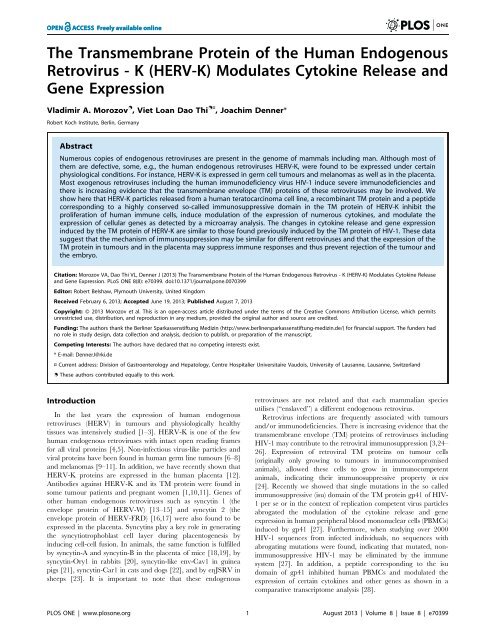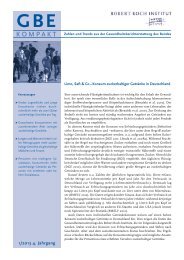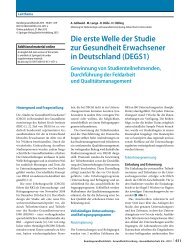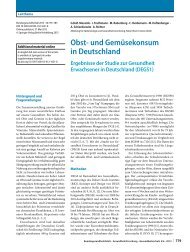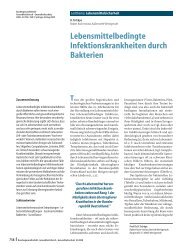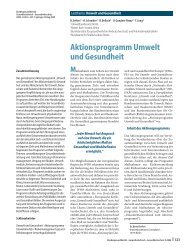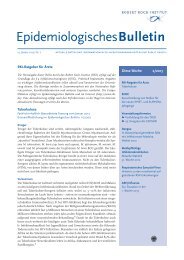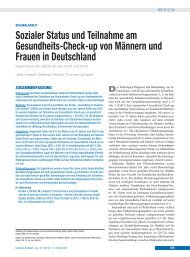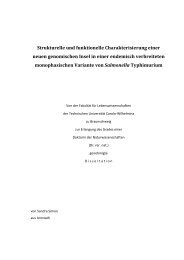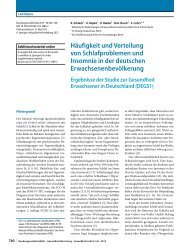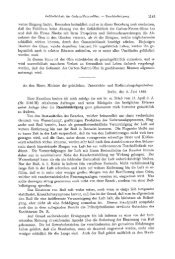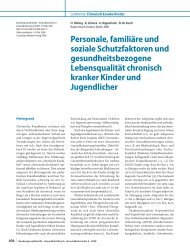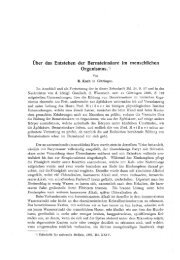HERV-K - RKI
HERV-K - RKI
HERV-K - RKI
Create successful ePaper yourself
Turn your PDF publications into a flip-book with our unique Google optimized e-Paper software.
The Transmembrane Protein of the Human Endogenous<br />
Retrovirus - K (<strong>HERV</strong>-K) Modulates Cytokine Release and<br />
Gene Expression<br />
Vladimir A. Morozov . , Viet Loan Dao Thi .¤ , Joachim Denner*<br />
Robert Koch Institute, Berlin, Germany<br />
Abstract<br />
Numerous copies of endogenous retroviruses are present in the genome of mammals including man. Although most of<br />
them are defective, some, e.g., the human endogenous retroviruses <strong>HERV</strong>-K, were found to be expressed under certain<br />
physiological conditions. For instance, <strong>HERV</strong>-K is expressed in germ cell tumours and melanomas as well as in the placenta.<br />
Most exogenous retroviruses including the human immunodeficiency virus HIV-1 induce severe immunodeficiencies and<br />
there is increasing evidence that the transmembrane envelope (TM) proteins of these retroviruses may be involved. We<br />
show here that <strong>HERV</strong>-K particles released from a human teratocarcinoma cell line, a recombinant TM protein and a peptide<br />
corresponding to a highly conserved so-called immunosuppressive domain in the TM protein of <strong>HERV</strong>-K inhibit the<br />
proliferation of human immune cells, induce modulation of the expression of numerous cytokines, and modulate the<br />
expression of cellular genes as detected by a microarray analysis. The changes in cytokine release and gene expression<br />
induced by the TM protein of <strong>HERV</strong>-K are similar to those found previously induced by the TM protein of HIV-1. These data<br />
suggest that the mechanism of immunosuppression may be similar for different retroviruses and that the expression of the<br />
TM protein in tumours and in the placenta may suppress immune responses and thus prevent rejection of the tumour and<br />
the embryo.<br />
Citation: Morozov VA, Dao Thi VL, Denner J (2013) The Transmembrane Protein of the Human Endogenous Retrovirus - K (<strong>HERV</strong>-K) Modulates Cytokine Release<br />
and Gene Expression. PLoS ONE 8(8): e70399. doi:10.1371/journal.pone.0070399<br />
Editor: Robert Belshaw, Plymouth University, United Kingdom<br />
Received February 6, 2013; Accepted June 19, 2013; Published August 7, 2013<br />
Copyright: ß 2013 Morozov et al. This is an open-access article distributed under the terms of the Creative Commons Attribution License, which permits<br />
unrestricted use, distribution, and reproduction in any medium, provided the original author and source are credited.<br />
Funding: The authors thank the Berliner Sparkassenstiftung Medizin (http://www.berlinersparkassenstiftung-medizin.de/) for financial support. The funders had<br />
no role in study design, data collection and analysis, decision to publish, or preparation of the manuscript.<br />
Competing Interests: The authors have declared that no competing interests exist.<br />
* E-mail: DennerJ@rki.de<br />
¤ Current address: Division of Gastroenterology and Hepatology, Centre Hospitalier Universitaire Vaudois, University of Lausanne, Lausanne, Switzerland<br />
. These authors contributed equally to this work.<br />
Introduction<br />
In the last years the expression of human endogenous<br />
retroviruses (<strong>HERV</strong>) in tumours and physiologically healthy<br />
tissues was intensively studied [1–3]. <strong>HERV</strong>-K is one of the few<br />
human endogenous retroviruses with intact open reading frames<br />
for all viral proteins [4,5]. Non-infectious virus-like particles and<br />
viral proteins have been found in human germ line tumours [6–8]<br />
and melanomas [9–11]. In addition, we have recently shown that<br />
<strong>HERV</strong>-K proteins are expressed in the human placenta [12].<br />
Antibodies against <strong>HERV</strong>-K and its TM protein were found in<br />
some tumour patients and pregnant women [1,10,11]. Genes of<br />
other human endogenous retroviruses such as syncytin 1 (the<br />
envelope protein of <strong>HERV</strong>-W) [13–15] and syncytin 2 (the<br />
envelope protein of <strong>HERV</strong>-FRD) [16,17] were also found to be<br />
expressed in the placenta. Syncytins play a key role in generating<br />
the syncytiotrophoblast cell layer during placentogenesis by<br />
inducing cell-cell fusion. In animals, the same function is fulfilled<br />
by syncytin-A and syncytin-B in the placenta of mice [18,19], by<br />
syncytin-Ory1 in rabbits [20], syncytin-like env-Cav1 in guinea<br />
pigs [21], syncytin-Car1 in cats and dogs [22], and by enJSRV in<br />
sheeps [23]. It is important to note that these endogenous<br />
retroviruses are not related and that each mammalian species<br />
utilises (‘‘enslaved’’) a different endogenous retrovirus.<br />
Retrovirus infections are frequently associated with tumours<br />
and/or immunodeficiencies. There is increasing evidence that the<br />
transmembrane envelope (TM) proteins of retroviruses including<br />
HIV-1 may contribute to the retroviral immunosuppression [3,24–<br />
26]. Expression of retroviral TM proteins on tumour cells<br />
(originally only growing to tumours in immunocompromised<br />
animals), allowed these cells to grow in immunocompetent<br />
animals, indicating their immunosuppressive property in vivo<br />
[24]. Recently we showed that single mutations in the so called<br />
immunosuppressive (isu) domain of the TM protein gp41 of HIV-<br />
1 per se or in the context of replication competent virus particles<br />
abrogated the modulation of the cytokine release and gene<br />
expression in human peripheral blood mononuclear cells (PBMCs)<br />
induced by gp41 [27]. Furthermore, when studying over 2000<br />
HIV-1 sequences from infected individuals, no sequences with<br />
abrogating mutations were found, indicating that mutated, nonimmunosuppressive<br />
HIV-1 may be eliminated by the immune<br />
system [27]. In addition, a peptide corresponding to the isu<br />
domain of gp41 inhibited human PBMCs and modulated the<br />
expression of certain cytokines and other genes as shown in a<br />
comparative transcriptome analysis [28].<br />
PLOS ONE | www.plosone.org 1 August 2013 | Volume 8 | Issue 8 | e70399
Properties of the Transmembrane Protein of <strong>HERV</strong>-K<br />
Here we demonstrate that the recombinant TM protein of<br />
<strong>HERV</strong>-K produced in yeast cells and a synthetic peptide<br />
corresponding to a conserved domain of the TM protein inhibit<br />
the proliferation of human and mouse immune cells, modulate the<br />
release of different cytokines such as the immunosuppressive IL-10<br />
and changes the expression of numerous genes in human PBMCs.<br />
In addition, <strong>HERV</strong>-K particles produced by human teratocarcinoma<br />
cells also induced IL-10 release. Since the TM protein of<br />
<strong>HERV</strong>-K was found to be expressed in germ line tumours and<br />
melanomas as well as in the placenta, its expression may<br />
contribute to the growth of the tumour and the protection of the<br />
embryo.<br />
Results<br />
The TM Protein of <strong>HERV</strong>-K Contains an<br />
Immunosuppressive (isu) Domain<br />
The structure of the TM protein of <strong>HERV</strong>-K is similar to that<br />
of other retroviruses (Figure 1a). The so-called immunosuppressive<br />
(isu) domain, which is conserved among retroviruses (Figure 1b), is<br />
located in proximity to the N-terminal end of the Cys-Cys loop.<br />
Retroviruses cluster in different groups according to the sequence<br />
of the isu domain. One group includes the gammaretroviruses,<br />
another the lentiviruses with the human (HIV-1, HIV-2) and<br />
simian (SIV) immunodeficiency viruses. <strong>HERV</strong>-K is different<br />
compared with these groups and contains amino acids from both<br />
groups as well as from another betaretrovirus, the mouse<br />
mammary tumour virus MMTV (Figure 1b). More than 80% of<br />
the published <strong>HERV</strong>-K sequences contain the isu domain<br />
LANQINDLRQTVIW. In rare cases the sequences LAS-<br />
QINDLRQTVIW and LANQINDLRQSVTW were found<br />
(Table S1), indicating a high conservation of this domain in all<br />
<strong>HERV</strong>-K proviruses in the human genome.<br />
Characterisation of the TM Protein of <strong>HERV</strong>-K Produced<br />
in Yeast<br />
To avoid contaminations with bacterial endotoxin, which may<br />
modulate the cytokine release when added to human PBMCs, the<br />
ectodomain of the TM protein of <strong>HERV</strong>-K was expressed in H.<br />
polymorpha and purified by affinity chromatography. Three<br />
molecules were expressed in transformed cells: 32 kDa, 30 kDa,<br />
and 20 kDa (Figure S1a). All three reacted with an antiserum<br />
induced by immunisation with the recombinant TM protein of<br />
<strong>HERV</strong>-K produced in E. coli and a serum against the His tag<br />
(Figure S1b, c). Since the predicted molecular weight of the<br />
protein backbone is nearly 17 kDa, we conclude that the proteins<br />
are glycosylated to a different extend. Noteworthy, most probably<br />
due to the glycan chains, the TM protein produced in yeast<br />
reacted less with the antiserum than the TM protein produced in<br />
E. coli that was used for immunisation (Figure S1). As a matter of<br />
fact, at least five epitopes were recognised in the TM protein [11],<br />
and one epitope contained one of the four predicted glycosylation<br />
sites (Figure S1d).<br />
The TM Protein of <strong>HERV</strong>-K and the Corresponding isu<br />
Peptide Inhibit Activation of PBMCs<br />
To study the influence of the TM protein of <strong>HERV</strong>-K on the<br />
activation of human immune cells, the purified glycosylated TM<br />
protein produced in yeast cells was added together with the T cell<br />
mitogen Concanavalin A (ConA) to PBMCs from healthy human<br />
blood donors. A significant inhibition of cell activation was<br />
observed when the TM protein of <strong>HERV</strong>-K was added in<br />
comparison to the bovine serum albumin (BSA) and to the<br />
Figure 1. Localisation and sequence of the immunosuppressive<br />
(isu) domain of the TM protein of <strong>HERV</strong>-K (accession number<br />
Q69384). a, Functional domains of the TM protein: FP, fusion peptide;<br />
FPPR, fusion peptide proximal region; NHR, N-terminal helical region;<br />
ISU, isu domain; C-C, cystein-cystein loop; CHR, C-terminal helical<br />
region; MPER, membrane proximal external region; MSD, membrane<br />
spanning domain. In the amino acid sequence of the isu domain stars<br />
(*) indicate NH 2 groups, points (.) mark COOH groups relevant for<br />
polymerisation. b, Sequence comparison of the core (1 corresponds to<br />
the amino acid 552, 14 to 535, acc. Nr. Q69384) of the immunosuppressive<br />
domain of different retroviruses (MuLV, murine leukaemia<br />
virus; CKS-17 consensus, consensus sequence of the gammaretroviruses<br />
PERV, porcine endogenous retrovirus; <strong>HERV</strong>-K, -W, -FRD; human<br />
endogenous retroviruses-K, -W, -FRD; HIV-1, -2, human immunodeficiency<br />
viruses - 1, -2¸ MMTV, mouse mammary tumour virus; <strong>HERV</strong>-K,<br />
human endogenous retrovirus-K). Amino acids identical to that in the<br />
first sequence of each group are indicated gray. In addition, amino acids<br />
present in all retroviruses are marked green, in all gammaretroviruses<br />
and <strong>HERV</strong>-K pink, in HIV-1 and <strong>HERV</strong>-K orange and in MMTV and <strong>HERV</strong>-K<br />
blue. In the sequence of HIV-1 the amino acids with high importance<br />
are shown in bold, mutation of these amino acids totally abrogated the<br />
activity to induce IL-10 [27].<br />
doi:10.1371/journal.pone.0070399.g001<br />
medium control as measured by two different methods (Figure 2a,<br />
b). This inhibition was dose-dependent. An inhibition was also<br />
observed when another T cell mitogen, phytohemagglutinin<br />
(PHA), was used (data not shown). Noteworthy, the proliferation<br />
assay based on 3 H-thymidine incorporation was measuring the<br />
inhibition more efficiently as compared to the Alamar blue assay.<br />
Inhibition of proliferation by the <strong>HERV</strong>-K TM was also observed<br />
PLOS ONE | www.plosone.org 2 August 2013 | Volume 8 | Issue 8 | e70399
Properties of the Transmembrane Protein of <strong>HERV</strong>-K<br />
in the case of murine splenocytes, indicating an interspecies effect<br />
(Figure 2c). Finally, carrier protein-conjugates of the peptide<br />
corresponding to the isu domain of the <strong>HERV</strong>-K TM protein<br />
equally lead to a dose-dependent inhibition of cell proliferation<br />
(Figure 3), narrowing down the inhibitory effect of the TM protein<br />
to this domain.<br />
The TM Protein of <strong>HERV</strong>-K Modulated Cytokine Release<br />
To analyse the influence of the TM protein of <strong>HERV</strong>-K on IL-<br />
10 release, PBMCs from two healthy human donors were<br />
incubated for 24 hrs with different doses of the purified protein<br />
and the amount of IL-10 was measured in the supernatant by<br />
ELISA (Figure 4a). Release of IL-10 was analysed because in the<br />
case of the TM protein gp41 of HIV-1 and the corresponding isu<br />
peptide a strong increase in IL-10 release was observed [25,27].<br />
Further on we analysed the influence of the TM protein of <strong>HERV</strong>-<br />
Figure 3. Influence of isu peptide-BSA conjugates on the<br />
activation of ConA-stimulated PBMCs from one healthy donor.<br />
Cell proliferation was measured by 3 H-thymidine incorporation. The 3 H-<br />
thymidine was added on day three and cells were then harvested the<br />
next day and the counts per minute were determined, black - BSA<br />
control, gray – isu peptide-BSA conjugates, added at day 0 (mean6SD;<br />
n = 3). It is a representative experiment out of 5.<br />
doi:10.1371/journal.pone.0070399.g003<br />
K on the expression of other cytokines. A microarray assay was<br />
performed to study the expression of 62 cytokines (Figure 4b,<br />
Table S2). An overexpression was observed for the following<br />
cytokines: IL-6, IL-8, IL-10, MCP-1, RANTES, MIP-1alpha,<br />
MIP-1beta, uPAR, sTNFRII, GCSF (for the full names and the<br />
cytokines with unchanged expression at 24 hrs see Table S2).<br />
Similar changes in the cytokine expression were observed when<br />
the isu peptide of the TM protein gp41 of HIV-1 was investigated<br />
in different assays [28].<br />
Donor Dependence of the Immunomodulatory Effect by<br />
the TM Protein of <strong>HERV</strong>-K<br />
When studying the effect of gp41 of HIV-1 and the<br />
corresponding isu peptide, some differences in the response<br />
among donors were observed [28]. To study this for <strong>HERV</strong>-K,<br />
PBMCs from 6 healthy human donors (5 male, 1 female, 5<br />
Caucasian, 1 African) were incubated with the same batch and the<br />
same amount of a polymer preparation of the isu peptide of<br />
<strong>HERV</strong>-K. Reproducible differences in the response were observed<br />
(Figure 5). PBMCs from four donors released a high level of IL-10<br />
(above 250 ng/ml), while PBMCs from two donors released less<br />
than 150 ng/ml, indicating a variable reactivity of the donors to<br />
the isu domain of <strong>HERV</strong>-K. When PBMCs from a high responder<br />
and from a low responder were tested again after 14 days the same<br />
differences in IL-10 release were observed.<br />
Figure 2. Influence of the recombinant TM protein of <strong>HERV</strong>-K<br />
on the proliferation of ConA-stimulated PBMCs from one<br />
healthy human blood donor (a, b) or murine splenocytes (c).<br />
Cell proliferation was measured using the Alamar blue assay (a, c) orby<br />
3 H-thymidine incorporation (b) (mean6SD; n = 3).<br />
3 H-thymidine was<br />
added on day three and cells were then harvested one the next day and<br />
the counts per minute were determined, dark gray – isu peptide-BSA<br />
conjugates, gray – BSA conjugates, added at day 0. Black (Pos, positive<br />
control) – medium alone.<br />
doi:10.1371/journal.pone.0070399.g002<br />
The TM Protein of <strong>HERV</strong>-K Modulated Gene Expression<br />
To study the influence of the TM protein of <strong>HERV</strong>-K on gene<br />
expression in human PBMCs, a genome wide microarray analysis<br />
(29.500 genes) was performed. The RNA was isolated from the<br />
PBMCs of a healthy blood donor 24 hrs after incubation with the<br />
TM protein of <strong>HERV</strong>-K. In this comparative transcriptome<br />
analysis RNA from PBMCs incubated in parallel with medium<br />
alone as well as with the isu peptide of the TM protein gp41 of<br />
HIV-1 was also analysed. When 2.5 mg TM protein of <strong>HERV</strong>-K<br />
and 12.5 mg isu peptide homopolymer of gp41 of HIV-1 were<br />
added to 3610 5 cells, both induced release of a similar amount of<br />
IL-10 (810 pg/ml).<br />
PLOS ONE | www.plosone.org 3 August 2013 | Volume 8 | Issue 8 | e70399
Properties of the Transmembrane Protein of <strong>HERV</strong>-K<br />
Figure 4. Influence of the <strong>HERV</strong>-K TM protein on the cytokine<br />
release by donor PBMCs. a, Dose-dependent induction of Il-10<br />
release in PBMCs from two donors by the TM protein of <strong>HERV</strong>-K (0–<br />
medium control) compared to control protein BSA as measured by<br />
ELISAs (mean6SD; n = 3). b, Cytokine array measuring simultaneous<br />
release of cytokines from human donor PBMCs incubated with the TM<br />
protein of <strong>HERV</strong>-K, or control protein BSA, or medium alone after 24 hrs<br />
incubation. The up-regulated cytokines are circled. A list of all analysed<br />
cytokines and their full names are given in Table S1.<br />
doi:10.1371/journal.pone.0070399.g004<br />
More than 300 genes were found up-regulated and more than<br />
300 genes were found down-regulated upon the incubation with<br />
the TM protein of <strong>HERV</strong>-K and the isu peptide of HIV-1. Ten<br />
genes of each group (up or down) with the highest fold change<br />
after incubation with the TM protein of <strong>HERV</strong>-K are shown in<br />
Figure 6. Fifty genes including the first ten genes with the highest<br />
change in expression are shown in Tables S3 (up) and S4 (down).<br />
The expression of the genes up- and down-regulated by the isu<br />
peptide of HIV-1 [28] are also shown for comparison in the Tables<br />
S3 (up) and S4 (down). Nearly the same genes were up- or downregulated,<br />
however with slight differences. For example, in the case<br />
of the isu peptide homopolymer of HIV-1 IL-6 has the first<br />
position in the list of the most up-regulated and MMP-1 (matrix<br />
metalloproteinase 1) the second, whereas in the case of the TM<br />
protein of <strong>HERV</strong>-K MMP-1 has the first position and IL-6 the<br />
second.<br />
As mentioned above, the highest up-regulation induced by the<br />
TM protein of <strong>HERV</strong>-K was shown for the gene of MMP-1<br />
(Figure 6, position 1). MMP-1 is a zinc-dependent protease<br />
essential for the breakdown of the extracellular matrix expressed<br />
on monocytes and macrophages [29]. The second highest upregulation<br />
was that of the IL-6 gene (Figure 6, position 2),<br />
confirming the results on the protein level as shown by the<br />
cytokine array (Figure 4b). Interestingly, the genes with higher<br />
expression are predominantly involved in two processes ‘‘Immunity<br />
and defense’’ and ‘‘Signal transduction’’. Another upregulated<br />
gene was TREM-1 (triggering receptor expressed on<br />
myeloid cells 1) (Figure 6, position 6). TREM-1 has a role as a<br />
regulator of innate and adaptive immunity [30,31].<br />
Figure 5. Influence of the homopolymer of the isu peptide of<br />
<strong>HERV</strong>-K on the IL-10 release by donor PBMCs. a, Comparison of<br />
the isu peptide homopolymer (grey) with a randomised peptide (dark<br />
grey). b, Comparison of the IL-10 release from PBMCs of six donors<br />
treated with one batch and the same amount of the isu peptide<br />
homopolymer, the IL-10 release of their PBMCs incubated with medium<br />
alone was zero.<br />
doi:10.1371/journal.pone.0070399.g005<br />
Among the down-regulated genes were SEPP1 (selenoprotein P<br />
plasma 1, position 1 in Figure 6), FCN1 (ficolin, position 2 in<br />
Figure 6), as well as FCN2 and TREM2 (position 4 and 6 in<br />
Figure 6). These molecules play an important role in innate<br />
immune responses [32–34].<br />
These results indicate that the recombinant TM protein of<br />
<strong>HERV</strong>-K produced in yeasts modulated the expression of<br />
numerous genes in human PBMCs and that this modulation is<br />
similar to that induced by the isu domain of the TM protein of<br />
HIV-1.<br />
<strong>HERV</strong>-K Particles Released from Human Teratocarcinoma<br />
Cells Modulated Cytokine Release<br />
Human GH germ cells express the TM protein of <strong>HERV</strong>-K on<br />
the cell surface and release pleomorphic non-infectious virus<br />
particles [4,7]. The particles were pelleted and purified by sucrose<br />
cushion centrifugation. By Western blot analysis the presence of<br />
the TM protein in the virus preparation was shown (Figure 7).<br />
Incubation of 3610 5 human PBMCs with virus particles<br />
containing approximately 10 ng TM protein (for calculation see<br />
Materials and Methods) induced the release of 80 pg IL-10/ml<br />
(Figure 7). Thus the activity of the virus particles is much stronger<br />
than that of the recombinant TM protein produced in yeast cells<br />
and that of peptide polymers. In parallel virus particles of the<br />
porcine endogenous retrovirus (PERV) were pelleted and assayed.<br />
Although approximately the same amount of PERV was added as<br />
calculated by similar amounts of their Gag capsid proteins, the<br />
induction of IL-10 was lower when compared with that induced by<br />
<strong>HERV</strong>-K (Figure 7).<br />
Discussion<br />
Most retroviruses exert an immunosuppressive effect when a<br />
certain virus load was reached in the infected host. Inactivated<br />
PLOS ONE | www.plosone.org 4 August 2013 | Volume 8 | Issue 8 | e70399
Properties of the Transmembrane Protein of <strong>HERV</strong>-K<br />
Figure 6. Genes with the highest up-regulation (upper part) or<br />
down-regulation (lower part) of their expression in PBMC of<br />
one donor in response to the incubation with the TM protein of<br />
<strong>HERV</strong>-K. Fold changes indicate gene expression compared to control<br />
cells incubated in medium. The full names of the genes and 40 other<br />
up- or down-regulated genes are given in Tables S2 and S3.<br />
doi:10.1371/journal.pone.0070399.g006<br />
retrovirus preparations, their TM proteins and synthetic peptides<br />
corresponding to the isu domain of their TM proteins were found<br />
to inhibit proliferation of PBMCs and to modulate the cytokine<br />
release and gene expression (for review see [25,26]). Previously we<br />
and others had shown that particles of HIV-1 [27,35], of PERV-A,<br />
PERV-B and the murine leukaemia virus (MuLV) [36], of FeLV<br />
[37,38], of the baboon endogenous retrovirus (BaEV), and of a<br />
deltaretrovirus [39,40] as well as of the Koala retrovirus (KoRV)<br />
[41] were able to inhibit lymphocyte activation and modulated IL-<br />
10 release in treated immune cells.<br />
To extend our studies on the immunosuppressive properties of<br />
retroviruses we investigated a human endogenous retrovirus,<br />
<strong>HERV</strong>-K. The influence of virus particles released from a human<br />
tumour cell line, of the TM protein and the isu peptide on immune<br />
cell proliferation and gene expression was studied using cytokine<br />
arrays and transcriptome comparison.<br />
We showed for the first time that <strong>HERV</strong>-K induced IL-10<br />
release from human PBMCs. We also showed that the recombinant<br />
TM protein of <strong>HERV</strong>-K produced in yeast cells and<br />
polymers of a peptide corresponding to the immunosuppressive<br />
domain of the TM protein inhibited immune cell activation, and<br />
modulated cytokine release and gene expression in human<br />
PBMCs.<br />
These data are of importance for the understanding of the role<br />
of endogenous retroviruses in carcinogenesis and embryogenesis.<br />
Previously we and others had shown that the TM protein of<br />
<strong>HERV</strong>-K is expressed in germ cell tumours and melanomas [11]<br />
as well as in the human placenta [12]. The data presented here<br />
suggest that the expression of the TM protein may contribute to<br />
Figure 7. Induction of IL-10 release in human PBMCs by <strong>HERV</strong>-<br />
K and PERV particles. a, Characterisation and estimation of the<br />
amount of added <strong>HERV</strong>-K and PERV by SDS-PAGE and Coomassie blue<br />
staining. <strong>HERV</strong>-K containing 60 ng Gag (capsid, CA) and PERV<br />
containing 100 ng Gag (capsid, CA) were loaded per lane and the<br />
amount of the Gag (CA) proteins was used for comparison. b, Detection<br />
of the TM protein gp36 of <strong>HERV</strong>-K in the pellet used for incubation with<br />
human PBMCs by a TM specific antiserum, M – marker, control –<br />
pelleted supernatant from uninfected 293 cells, <strong>HERV</strong>-K – pelleted<br />
supernatant from GH cells. c, IL-10 release by human PBMCs induced by<br />
<strong>HERV</strong>-K particles, by the pellet from the supernatant of uninfected 293<br />
cells corresponding to the same amount of supernatant (control), and<br />
by purified PERV particles produced on 293 cells. Virus containing<br />
approximately 100 ng Gag (CA) protein, which was used for comparison<br />
(see below) and 10 ng TM protein, was added to the first well (1), the<br />
dilutions 50/5 ng (2) and 25/2.5 ng (3) are also shown. IL-10 was<br />
measured after 24 hrs of incubation.<br />
doi:10.1371/journal.pone.0070399.g007<br />
the suppression of the immune system and thus prevent the<br />
rejection of the tumour cells as well as of the embryo, which<br />
immunologically represents a semi-allotransplant. In fact, an<br />
elevated IL-10 expression was seen in tumour patients as well as in<br />
pregnant women [42–48]. In particular, plasma IL-10 was steadily<br />
increasing during gestation (week 12, p,0.05, week 20, p,0.01<br />
and week 35, p,0.0001, respectively) [42]. Using an antiserum<br />
against the TM protein of <strong>HERV</strong>-K we found expression of this<br />
protein in the placenta in villous cytotrophoblast and extravillous<br />
cytotrophoblast (EVT) cells invading the decidua [12]. The fact<br />
that EVT cells expressing c-erbB2 coding for the human<br />
epidermal growth factor (EGF) receptor 2 (ErbB2) [49] are<br />
regularly found in intimate contact with maternal immune cells<br />
suggests a potential role of <strong>HERV</strong>-K in the induction of the<br />
immunosuppression. When such invasive EVT cells were isolated<br />
by ErbB2 affinity chromatography they were found to express the<br />
TM protein of <strong>HERV</strong>-K at a high level [12]. Noteworthily, in the<br />
placenta at least three other endogenous retroviruses are<br />
expressed, <strong>HERV</strong>-W, <strong>HERV</strong>-FRD and ERV-3 [50–52]. The<br />
envelope protein of <strong>HERV</strong>-W, which is not immunosuppressive<br />
in vivo, corresponds to syncytin-1 and the envelope protein of<br />
<strong>HERV</strong>-FRD, which is immunosuppressive in vivo, corresponds to<br />
syncytin-2 [50]. The envelope protein of <strong>HERV</strong>-R (ERV3) is also<br />
PLOS ONE | www.plosone.org 5 August 2013 | Volume 8 | Issue 8 | e70399
Properties of the Transmembrane Protein of <strong>HERV</strong>-K<br />
immunosuppressive [51]. Elevated plasma levels of IL-10 were<br />
also reported for patients with melanomas [43–48]. However it is<br />
not quite clear, whether IL-10 is produced by the tumour cells, by<br />
the immune cells or both. When we studied the expression of IL-<br />
10 in melanoma cell lines with measured expression of the TM<br />
protein of <strong>HERV</strong>-K [11], no IL-10 release was detected in the<br />
supernatant (unpublished).<br />
The fact that <strong>HERV</strong>-K particles, its TM protein and a synthetic<br />
peptide corresponding to the isu domain induce the same changes<br />
in cytokine expression indicates that the isu domain is the<br />
biologically active domain in the virus. Although the isu domain is<br />
conserved among retroviruses, there are differences in the<br />
sequence of the domain of the gammaretroviruses, of the<br />
corresponding sequence of the lentiviruses and that of <strong>HERV</strong>-K<br />
(Figure 1). It is of interest that the sequence of the isu domain of<br />
<strong>HERV</strong>-K is mosaic and contains one amino acids present in all<br />
retroviruses, and in addition: one in the gammaretroviruses, one in<br />
the lentiviruses and three in MMTV (Figure 1b). It is also<br />
important to note that the majority of the <strong>HERV</strong>-K proviruses,<br />
especially those highly expressed in melanomas, e.g., <strong>HERV</strong>-K6<br />
[53], contains the sequence present in the TM protein and in the<br />
peptide used in this study. The importance of this domain was<br />
underlined in the case of HIV-1 by mutation in the isu domain.<br />
Six mutations abrogated the influence of the isu domain on<br />
cytokine release totally, while others not [27]. The amino acids<br />
which when mutated abrogated the effect on cytokine release<br />
totally are shown in the sequence of the isu domain of HIV-1 in<br />
Figure 1 in bold. At least three of them are the most conserved<br />
among all retroviruses. The influence of the mutations in the<br />
minor sequences of the isu domain of HIV-1 is difficult to predict,<br />
however analysis of the conformation using the PROTEAN<br />
program showed no significant differences between the variants of<br />
<strong>HERV</strong>-K.<br />
The mechanism of interaction between the isu domain of the<br />
TM proteins and the immune cells is still unknown.<br />
First, the conformation of the immunosuppressive domain<br />
seems to be important for the immunomodulatory activity.<br />
Whereas conjugates of the isu peptide with a carrier protein or<br />
homopolymers of the isu peptide are active, the monomer did not<br />
show activity [54,55]. When we compared gp41 of HIV-1<br />
produced in human cells with the homopolymers of the isu<br />
peptide of gp41, 700 fold more polymers had to be used to obtain<br />
the same release of IL-10 [27]. The difference is certainly due to<br />
the conformation of the isu domain in the trimeric gp41 compared<br />
with the artificial peptide homopolymer. Differences in the<br />
immunomodulatory activity between retroviruses may explain<br />
the differences in IL-10 induction between PERV and <strong>HERV</strong>-K<br />
(Figure 7). The slight differences in the expression of cellular genes<br />
induced by the isu peptide polymer of HIV-1 on one site and the<br />
TM protein of <strong>HERV</strong>-K on the other also argues in favour of that<br />
possibility (Tables S3, S4).<br />
Second, the search for a specific receptor revealed some binding<br />
partners [56–59]. However, their function in the signal transduction<br />
leading to the cytokine modulation is unknown. For<br />
gammaretroviruses and HIV several signal transduction pathways<br />
were described and an inhibition of the protein kinase C by the isu<br />
peptide was shown [60–65]. The donor dependence suggests that<br />
genetic host factors (receptor polymorphism or differences in signal<br />
transduction?) may contribute to the biological activity. It is<br />
important to note, that genes involved in innate immunity such as<br />
SEPP1, FCN1, FCN2 and TREM2 were downregulated. This<br />
allows the virus to manipulate the immune system from the very<br />
first moment of infection.<br />
An interesting example of the complex interaction of the isu<br />
domain with cells of the immune system is given here in detail.<br />
Among the proteins with a higher expression after incubation of<br />
human PBMCs with the TM protein of <strong>HERV</strong>-K are the<br />
urokinase-type plasminogen activator receptor (uPAR) and the<br />
soluble tumour necrosis factor receptor type II (sTNFRII)<br />
(Figure 4b), similarly as it was observed after incubation with the<br />
isu peptide of HIV-1 and the TM protein of PERV (unpublished).<br />
uPAR is a cell-surface receptor expressed on monocytes and<br />
macrophages, which also exists in soluble and cleaved forms. Its<br />
ligand, the serine-protease uPA, acts proteolytic on the cell<br />
membrane, degrading surrounding extracellular material (ECM).<br />
In addition, uPAR can bind with high affinity a component of the<br />
ECM, vitronectin, and associate to cell surface molecules such as<br />
formyl-peptide receptors (FPR) and integrins to activate signalling<br />
pathways inside the cells. This means that uPAR plays an<br />
important role in cell proliferation/survival and adhesion/<br />
migration, which are crucial events for an efficient immune<br />
response to infectious agent [66]. sTNFRII is a soluble variant of<br />
the extracellular domain of the receptor II of the tumour necrosis<br />
factor (TNF) which is derived from the membrane bound form by<br />
the proteolytic activity of a metalloproteinase. sTNFRII is still able<br />
to bind to TNF and acts as natural inhibitor of TNF by<br />
sequestering soluble TNF and preventing it to bind to its receptor<br />
[67]. Interestingly, expression of the metalloproteinase MMP-1<br />
was also increased by the TM proteins of <strong>HERV</strong>-K (Figure 5) and<br />
HIV-1 [28].<br />
Taken together, the previously obtained results and the present<br />
study suggest that the immunosuppressive activity may be an<br />
intrinsic property of the TM proteins of retroviruses. Further<br />
studies searching for a putative receptor as well as investigating the<br />
signal transduction pathways leading to the described changes in<br />
the cytokine expression should be carried out.<br />
Materials and Methods<br />
Cells<br />
The human teratocarcinoma cell line GH, kindly provided by<br />
R. Löwer [4], and 293T cells (ATCC CRL11268) were<br />
maintained in DMEM supplemented with 10% heat-inactivated<br />
fetal calf serum, antibiotics and L-glutamine. 293T cells were<br />
infected with stocks of PERV-A/C [68] by spinoculation at 2000 g<br />
for 40 min, splitted and supernatant was collected every second<br />
day.<br />
Cloning, Expression in Yeast Cells and Purification of the<br />
TM Protein of <strong>HERV</strong>-K<br />
The ectodomain of the transmembrane envelope protein of<br />
<strong>HERV</strong>-K 108 (which is identical with HML2-HOM, K(C7),<br />
ERVK-6, located on chromosome 7p22.1) [10] was re-cloned into<br />
the expression vector pFPMT121-MFa-His6-TCS [69] with the<br />
signal peptide of the mating factor a (MFa), an inducible promotor<br />
element of the methanol oxidase (MOX) gene and a 6 His. Recloning<br />
was achieved using Not I and Bgl II. The expression vector<br />
was transformed into competent yeast cells (H. polymorpha) by<br />
electroporation. Although the MFa signal peptide was present, the<br />
protein was not released into the supernatant. Therefore cells were<br />
disrupted by 8 M urea and 0.3% SDS and the protein was purified<br />
using His tag affinity chromatography.<br />
Preparation of Isu Peptide Conjugates<br />
The <strong>HERV</strong>-K derived isu peptide was produced and conjugated<br />
to bovine serum albumin (BSA) as previously described<br />
using EDC (1-Ethyl-3-[3-dimethylaminopropyl]carbodiimide hy-<br />
PLOS ONE | www.plosone.org 6 August 2013 | Volume 8 | Issue 8 | e70399
Properties of the Transmembrane Protein of <strong>HERV</strong>-K<br />
drochloride) [54]. In addition, the isu peptide (KLAN-<br />
QINDLRQTVIWMGDR) (Figure 1) and a randomised peptide<br />
(DILDMRVWKQANGRTLIQN), produced by JPT Berlin, were<br />
used for the preparation of homopolymers by cross-linking using<br />
EDC and NHS (N-hydroxysuccinimid) (Pierce) as recommended<br />
by the supplier.<br />
Isolation of <strong>HERV</strong>-K and PERV Particles<br />
Supernatants from GH cells producing <strong>HERV</strong>-K and 293T<br />
cells producing PERV were centrifuged at 1200 g for 10 min and<br />
at 4000 g for 15 min. Then the supernatants were filtered through<br />
0.45 mm filters (Millipore), and centrifuged at 28000 rpm (rotor<br />
SW32Ti, Beckman, Ireland) for 3 hrs. The pellet was resuspended<br />
in PBS and centrifuged through a 20% sucrose cushion at<br />
36000 rpm (rotor SW 50.1Ti, Beckman) for 3 hrs. Virus pellets<br />
from initial 100 ml supernatant were resuspended in 50 ml PBS<br />
and used immediately or stored at 280uC until use. The amount<br />
of TM protein in the preparation was calculated based on the<br />
amount of the Gag (capsid, CA) protein using serial dilutions of<br />
BSA as standard and the assumption that particles contain<br />
approximately 10 times more Gag (CA) than TM protein. Virus<br />
preparations and control supernatants from uninfected cells were<br />
added to PBMCs after six cycles of freeze-thawing procedure.<br />
SDS-PAGE, Native PAGE and Western Blot Analysis<br />
Electrophoresis was performed in Tris-Glycine 4%–20%<br />
gradient gels using SDS Tris-Glycine sample buffer (Novex, Life<br />
technologies Carlsbad, CA, USA). Proteins were transferred onto<br />
Protran BA83 0.2 mm membrane (Whatman GmbH, Dassel,<br />
Germany) at 45 V for 2 hrs. Membranes were blocked with 6%<br />
skimmed milk in PBS with 0.1% Tween 20 (blocking buffer) for<br />
3 hrs at room temperature or overnight at 4uC, incubated for<br />
2 hrs at room temperature with a goat serum against the TM<br />
protein of <strong>HERV</strong>-K [10,11] (1:300). After five times (5 min each)<br />
washing in PBS with 0.1% Tween 20 (PBS-Tween) the<br />
membranes were incubated for 1 h with anti-goat IgG-HRP<br />
conjugate (Dako Laboratories, Glostrup, Denmark) diluted<br />
1:10000 in blocking buffer. The membranes were washed five<br />
times (5 min each) in PBS-Tween, treated for 1 min with Pierce<br />
ECL Western blotting substrate (Pierce, Rockford, IL, USA) and<br />
exposed to CL-XPosure film (Thermo Scientific, USA). The<br />
molecular mass was determined using a mixture of the following<br />
markers: Page Ruler Plus Prestained Protein Ladder (Fermentas<br />
Life Science) and Magic Mark XP Western Protein Standard<br />
(Invitrogen).<br />
Isolation of Human PBMCs and Murine Spleen Cells<br />
Human PBMCs were isolated from whole blood of healthy<br />
donors by Ficoll-Hypaque (PAA Laboratories, Austria) density<br />
centrifugation using Leucosep tubes (Greiner, Germany). Isolated<br />
PBMCs were cultivated with the <strong>HERV</strong>-K TM protein or BSA at<br />
37uC in RPMI 1640 with 10% fetal calf serum (FCS, Biochrome<br />
AG, Berlin, Germany) which had been selected for very low<br />
induction of IL-10 in normal PBMCs or medium alone. Spleen<br />
cells were obtained from BALB/c mice by mechanical disruption<br />
and subsequently washed and incubated in RPMI 1640 with 10%<br />
FCS.<br />
Proliferation Assays<br />
Proliferation assays using 3 H-thymidine were performed by<br />
stimulating 3.25610 6 donor PBMCs or murine spleen cells with<br />
10 mg/ml Concanavalin A (ConA, Sigma) in the presence or<br />
absence of the <strong>HERV</strong>-K TM protein or the isu peptide conjugated<br />
to BSA. After incubation at 37uC and 5% CO 2 for 40 hrs 3 H-<br />
thymidine (1 mCi/well) was added and the cells were incubated for<br />
additional 24 h at 37uC and then harvested. Counts per minute<br />
(cpm) were determined using a Micro Beta Trilux Scintillation and<br />
Luminescence counter (Perkin Elmer) or by a 96-well plate betacounter<br />
as described previously [28,54]. In addition, Alamar blue<br />
proliferation assays were performed. 3.25610 6 donor PBMCs<br />
were incubated with the <strong>HERV</strong>-K TM protein or with control<br />
BSA, with and without 10 mg/ml Concanavalin A (ConA, Sigma).<br />
After 48 hrs at 37uC and 5% CO 2 20 ml of Alamar blue<br />
(Biosource International) were added to each well and after<br />
additional incubation for 8 hrs the plates were measured in an<br />
ELISA reader Spectra Classic (Tecan) at wavelengths 560 nm and<br />
620 nm. The D values of both results were counted as the specific<br />
adsorption.<br />
Enzyme-linked Immunosorbent Assays for IL-10<br />
Supernatants from donor PMBCs either untreated or treated for<br />
24 hrs with the TM protein of <strong>HERV</strong>-K were collected by<br />
centrifugation at 2000 g for 10 min and tested for IL-10 by<br />
ELISA according to the protocol of the supplier (BD Biosciences,<br />
San Diego, USA).<br />
Cytokine Arrays<br />
Cytokine release in the supernatant of treated or untreated<br />
donor PBMCs were measured by a membrane-based cytokine<br />
array VI (RayBiotech, Inc.) after 24 hrs allowing measurement of<br />
62 different cytokines.<br />
RNA Isolation from PBMCs<br />
Total RNA was isolated from donor PBMCs using the RNeasy<br />
kit (Qiagen, Hilden, Germany). The RNA concentration was<br />
measured using a NanoDrop spectrometer ND-100 (PEQLAB),<br />
and RNA specimens were used immediately or kept at 280uC<br />
before use.<br />
Microarray<br />
Total RNA was prepared as described above. An RNA integrity<br />
numbers (RIN) of 9.1 and 8.8 were determined for the RNA from<br />
PBMCs cultured with medium or the TM protein of <strong>HERV</strong>-K,<br />
respectively (RIN 10 is the highest). The microarray was<br />
performed by IMGM Laboratories, Munich. 0.5 mg of total<br />
RNA were converted into digoxigenin (DIG)-labeled cRNA in a<br />
reverse transcriptase in vitro transcription (RT-IVT), 10 mg were<br />
fragmented and hybridised using a Human Genome Survey<br />
Microarray V2.0 plate from Applied Biosystems. After washing, an<br />
anti-DIG-AP-conjugate (Roche, Germany) was applied and signals<br />
were detected with an AB1700 Microarray Reader.<br />
Ethical Statement<br />
The use of human blood has been approved by the ethical<br />
commission at the Medical Faculty of the Humboldt University<br />
Berlin. Written informed consent was provided by study participants.<br />
This study was carried out in strict accordance with the<br />
German Animal Protection Act and was approved by the<br />
Landesamt für Gesundheit und Soziales (LAGeSo) Berlin. All<br />
efforts were made to minimize suffering.<br />
Supporting Information<br />
Figure S1 Characterisation of the TM protein of <strong>HERV</strong>-<br />
K produced in yeast cells. a, SDS-PAGE of the purified<br />
protein stained by Coomassie blue. Arrows indicate the 20, 30 and<br />
32 kDa proteins. b, Western blot analysis using an antibody<br />
PLOS ONE | www.plosone.org 7 August 2013 | Volume 8 | Issue 8 | e70399
Properties of the Transmembrane Protein of <strong>HERV</strong>-K<br />
specific for the His-tag. c, Western blot analysis using a goat serum<br />
specific for the TM protein produced in E. coli. M -– marker<br />
proteins, 1– TM protein produced in yeast cells and purified by<br />
His-tag affinity chromatography. 2– bovine serum albumin, 3 -<br />
TM protein produced as calmodulin binding fusion protein in E.<br />
coli. d, Amino acid sequence of the entire TM protein of <strong>HERV</strong>-K<br />
and the epitopes recognised by the goat serum after immunisation<br />
with the TM protein produced in E. coli. Blue – sequence of the<br />
ectodomain of the TM protein used for immunisation, red – Asn-<br />
Xaa-Ser/Thr sequences, green – immunosuppressive domain,<br />
underlined – potential glycosylation site according the NetNGlyc<br />
1.0 program, brown – Cys – Cys loop.<br />
(TIF)<br />
Table S1 Examples of the sequences of the isu domain<br />
of different <strong>HERV</strong>-K proviruses. Mutations are marked in<br />
red.<br />
(DOCX)<br />
Table S2 Abbreviations and full names of the cytokines<br />
tested for (see Fig. 4). Cytokines with increased expression are<br />
shown in red.<br />
References<br />
1. Löwer R, Löwer J, Kurth R (1996) The viruses in all of us: characteristics and<br />
biological significance of human endogenous retrovirus sequences. Proc Natl<br />
Acad Sci 93: 5177–5184.<br />
2. Ruprecht K, Mayer J, Sauter M, Roemer K, Mueller-Lantzsch N, et al. (2008)<br />
Endogenous retroviruses and cancer. Cell Mol Life Sci 65: 3366–3382.<br />
3. Denner J (2010) Endogenous retroviruses. In: Kurth R, Bannert N, editors.<br />
Retroviruses: Molecular biology, genomics and pathogenesis. Hethersett: Caister<br />
Academic Press, 35–69.<br />
4. Löwer R, Boller K, Hasenmaier B, Korbmacher C, Müller-Lantzsch N, et al.<br />
(1993) Identification of human endogenous retroviruses with complex mRNA<br />
expression and particle formation. Proc Nat Acad Sci 90: 4480–4484.<br />
5. Turner G, Barbulescu M, Su M, Jensen-Seaman MI, Kidd KK, et al. (2001)<br />
Insertional polymorphisms of full-length endogenous retroviruses in humans.<br />
Curr Biol 11: 1531–1535.<br />
6. Boller K, König H, Sauter M, Mueller-Lantzsch N, Löwer R, et al. (1993)<br />
Evidence that <strong>HERV</strong>-K ist the endogenous retrovirus sequence that codes for<br />
the human teratocarcinoma-derived retrovirus HDTV. Virology 196: 349–353.<br />
7. Löwer J, Löwer R, Stegmann J, Frank H, Kurth R, et al. (1981) Retrovirus<br />
particle production in three of four human teratocarcinoma cell lines. Haematol<br />
Blood Transfus 26: 541–544.<br />
8. Sauter M, Schommer S, Kremmer E, Remberger K, Dölken G, et al. (1995)<br />
Human endogenous retrovirus K10:expression of Gag protein and detection of<br />
antibodies in patients with seminomas. J Virol 69: 414–421.<br />
9. Muster T, Waltenberger A, Grassauer A, Hirschl S, Caucig P, et al. (2003) An<br />
endogenous retrovirus derived from human melanoma cells. Cancer Res 63:<br />
8735–8741.<br />
10. Büscher K, Trefzer U, Hofmann M, Sterry W, Kurth R, et al. (2005) Expression<br />
of human endogenous retrovirus K in melanomas and melanoma cell lines.<br />
Cancer Res 65: 4172–4180.<br />
11. Büscher K, Hahn S, Hofmann M, Trefzer U, Ozel M, et al. (2006) Expression of<br />
the human endogenous retrovirus-K transmembrane evelope, Rec and Np9<br />
proteins in melanomas and melanoma cell lines. Melanoma Res 16: 223–234.<br />
12. Kämmerer U, Germeyer A, Stengel S, Kapp M, Denner J (2011) Human<br />
endogenous retrovirus K (<strong>HERV</strong>-K) is expressed in villous and extravillous<br />
cytotrophoblast cells of the human placenta. J Reprod Immunol 91: 1–8.<br />
13. Blond JL, Beseme F, Duret L, Bouton O, Bedin F, et al. (1999) Molecular<br />
characterization and placental expression of <strong>HERV</strong>-W, a new human<br />
endogenous retrovirus family. J Virol 73: 1175–1185.<br />
14. Blond JL, Lavillette D, Cheynet V, Bouton O, Oriol G, et al. (2000) An envelope<br />
glycoprotein of the human endogenous retrovirus <strong>HERV</strong>-W is expressed in the<br />
human placenta and fuses cells expressing the type D mammalian retrovirus<br />
receptor. J Virol 74: 3321–29.<br />
15. Mi S, Lee X, Li X, Veldman GM, Finnerty H, et al. (2000) Syncytin is a captive<br />
retroviral envelope protein involved in human placental morphogenesis. 403:<br />
785–789.<br />
16. Malassine IA, Blaise S, Handschuh K, et al. (2007) Expression of the fusogenic<br />
<strong>HERV</strong>-FRD Env glycoprotein (syncytin 2) in human placenta is restricted to<br />
villous cytotrophoblastic cells. Placenta 28: 185–191.<br />
17. Malassine A, Frendo JL, Blaise S, Handschuh K, Gerbaud P, et al. (2008)<br />
Human endogenous retrovirus-FRD envelope protein (syncytin 2) expression in<br />
normal and trisomy 21-affected placenta. Retrovirology 5: 6.<br />
18. Dupressoir A, Marceau G, Vernochet C, Bénit L, Kanellopoulos C, et al. (2005)<br />
Syncytin-A and syncytin-B, two fusogenic placenta-specific murine envelope<br />
(DOCX)<br />
Table S3 Results of the microarray analysis: Upregulated<br />
genes.<br />
(DOCX)<br />
Table S4 Results of the microarray analysis: Downregulated<br />
genes.<br />
(DOCX)<br />
Acknowledgments<br />
We would like to thank Martina Keller, Rayk Behrendt and Karin<br />
Braunmüller for excellent technical support.<br />
Author Contributions<br />
Conceived and designed the experiments: JD. Performed the experiments:<br />
VAM VLDT JD. Analyzed the data: VAM VLDT JD. Wrote the paper:<br />
VAM JD VLDT.<br />
genes of retroviral origin conserved in Muridae. Proc Natl Acad Sci 102: 725–<br />
730.<br />
19. Dupressoir A, Vernochet C, Harper F, Guégan J, Dessen P, et al. (2011) A pair<br />
of co-opted retroviral envelope syncytin genes is required for formation of the<br />
two-layered murine placental syncytiotrophoblast. Proc Natl Acad Sci 108:<br />
E1164–1173.<br />
20. Heidmann O, Vernochet C, Dupressoir A, Heidmann T, et al. (2009)<br />
Identification of an endogenous retroviral envelope gene with fusogenic activity<br />
and placenta-specific expression in the rabbit: a new ‘‘syncytin’’ in a third order<br />
of mammals. Retrovirology 6: 107.<br />
21. Vernochet C, Heidmann O, Dupressoir A, Cornelis G, Dessen P, et al. (2011) A<br />
syncytin-like endogenous retrovirus envelope gene of the guinea pig specifically<br />
expressed in the placenta junctional zone and conserved in Caviomorpha.<br />
Placenta 32: 885–892.<br />
22. Cornelis G, Heidmann O, Bernard-Stoecklin S, Reynaud K, Véron G, et al.<br />
(2012) Ancestral capture of syncytin-Car1, a fusogenic endogenous retroviral<br />
envelope gene involved in placentation and conserved in Carnivora. Proc Natl<br />
Acad Sci 109: 432–441.<br />
23. Arnaud F, Varela M, Spencer TE, Palmarini M. et al. (2008) Coevolution of<br />
endogenous betaretroviruses of sheep and their host. Cell Mol Life Sci 65: 3422–<br />
3432.<br />
24. Mangeney M, Heidmann T (1998) Tumor cells expressing a retroviral envelope<br />
escape immune rejection in vivo. Proc Natl Acad Sci 95: 14920–14925.<br />
25. Denner J (1998) Immunosuppression by retroviruses: implications for xenotransplantation.<br />
Ann NY Acad Sci 862: 75–86.<br />
26. Oostendorp RA, Meijer CJ, Scheper RJ (1993) Immunosuppression by<br />
retroviral-envelope-related proteins, and their role in non-retroviral human<br />
disease. Crit Rev Oncol Hematol 14: 189–206.<br />
27. Morozov VA, Morozov AV, Semaan M, Denner J (2012) Single mutations in<br />
the transmembrane envelope protein abrogate the immunosuppressive property<br />
of HIV-1. Retrovirology 9(1): 67.<br />
28. Denner J, Eschricht M, Lauck M, Semaan M, Schlaermann P, et al. (2013)<br />
Modulation of cytokine release and gene expression by the immunosuppressive<br />
domain of gp41 of HIV-1. PLOS ONE, 8(1).<br />
29. Woessner F, Nagase H, eds. (2000) Matrix metalloproteinases and TIMPs, New<br />
York: Oxford University Press.<br />
30. Bleharski JR, Kiessler V, Buonsanti C, Sieling PA, Stenger S, et al. (2003) A role<br />
for triggering receptor expressed on myeloid cells-1 in host defense during the<br />
early-induced and adaptive phases of the immune response. J Immunol 170:<br />
3812–3818.<br />
31. Bouchon A, Dietrich J, Colonna M (2000) Cutting edge: inflammatory responses<br />
can be triggered by TREM-1, a novel receptor expressed on neutrophils and<br />
monocytes. J Immunol 164: 4991–4995.<br />
32. Endo Y, Matsushita M, Fujita T (2007) Role of ficolin in innate immunity and its<br />
molecular basis. Immunobiology 212: 371–379.<br />
33. Hurwitz BE, Klaus JR, Llabre MM, Gonzalez A, Lawrence PJ, et al. (2007)<br />
Suppression of human immunodeficiency virus type 1 viral load with selenium<br />
supplementation: a randomized controlled trial. Arch Intern Med 167: 148–154.<br />
34. Ford JW, McVicar DW (2009) TREM and TREM-like receptors in<br />
inflammation and disease. Curr Opin Immunol 21: 38–46.<br />
35. Amadori A, Fualkner-Valle GP, DeRossi A, Zanovello P, Collavo D, et al.<br />
(1988) HIV-mediated immunosuppression: In vitro inhibition of T-lymphocyte<br />
PLOS ONE | www.plosone.org 8 August 2013 | Volume 8 | Issue 8 | e70399
Properties of the Transmembrane Protein of <strong>HERV</strong>-K<br />
proliferative response by ultraviolet-inactivated virus. Cell Immunol Immunopathol<br />
46: 37–54.<br />
36. Tacke SJ, Kurth R, Denner J (2000) Porcine endogenous retroviruses inhibit<br />
human immune cell function: risk for xenotransplantation? Virology 268: 87–93.<br />
37. Schaller JP, Hoover EA, Olsen RG (1977) Active and passive immunization of<br />
cats with inactivated feline oncornaviruses. J Natl Cancer Inst. 59(5): 1441–1450.<br />
38. Olsen RG, Hoover EA, Schaller JP, Mathes LE, Wolff LH (1977) Abrogation of<br />
resistance to feline oncornavirus disease by immunisation with killed feline<br />
leukemia virus. Cancer Res., 37, 2082–2085.<br />
39. Denner J, Wunderlich V, Sydow G (1985) Suppression of human lymphocyte<br />
mitogen response by retroviruses of type D. I. Action of highly purified intact<br />
and disrupted virus. Arch Virol 86(3–4): 177–86.<br />
40. Denner J, Wunderlich V, Bierwolf D (1980) Suppression of human lymphocyte<br />
mitogen response by disrupted primate retroviruses of type C (baboon<br />
endogenous virus) and type D (PMFV). Acta Biol Med Germ. 39(11–12):<br />
K19–26.<br />
41. Fiebig U, Hartmann MG, Bannert N, Kurth R, Denner J (2006) Transspecies<br />
transmission of the endogenous koala retrovirus. J Virol 80: 5651–5654.<br />
42. Holmes VA, Wallace JM, Gilmore WS, McFaul P, Alexander HD, et al. (2003)<br />
Plasma levels of the immunomodulatory cytokine interleukin-10 during normal<br />
human pregnancy: a longitudinal study. Cytokine 21: 265–269.<br />
43. Botella-Estrada R, Dasi F, Ramos D, Nagore E, Herrero MJ, et al. (2005)<br />
Cytokine expression and dendritic cell density in melanoma sentinel nodes.<br />
Melanoma Res 15: 99–106.<br />
44. Lee JH, Torisu-Itakara H, Cochran AJ, Kadison A, Huynh Y, et al. (2005)<br />
Quantitative analysis of melanoma-induced cytokine-mediated immunosuppression<br />
in melanoma sentinel nodes. Clin Cancer Res 11: 107–112.<br />
45. Gerlini G, Tun-Kyi A, Dudli C, Burg G, Pimpinelli N, et al. (2004) Metastatic<br />
melanoma secreted IL-10 down-regulates CD1 molecules on dendritic cells in<br />
metastatic tumor lesions. J Pathol 165: 1853–1863.<br />
46. Brewer G, Saccani S, Sarkar S, Lewis A, Pestka S (2003) Increased interleukin-<br />
10 mRNA stability in melanoma cells is associated with decreased levels of A+Urich<br />
element binding factor AUF1. J Interferon Cytokine Res 23: 553–564.<br />
47. Dummer W, Becker JC, Schwaaf A, Leverkus M, Moll T, et al. (1995) Elevated<br />
serum levels of interleukin-10 in patients with metastatic malignant melanoma.<br />
Melanoma Res 5: 67–68.<br />
48. Conrad CT, Ernst NR, Dummer W, Bröcker EB, Becker JC, et al. (1999)<br />
Differential expression of transforming growth factor beta 1 and interleukin 10 in<br />
progressing and regressing areas of primary melanoma. J Exp Clin Cancer Res<br />
18: 225–232.<br />
49. Jokhi PP, King A, Loke YW (1994) Reciprocal expression of epidermal growth<br />
factor receptor (EGF-R) and c-erbB2 by noninvasive and invasive human<br />
trophoblast populations. Cytokine 6: 433–442.<br />
50. Mangeney M, Renard M, Schlecht-Louf G, Bouallaga I, Heidmann O, et al.<br />
(2007) Placental syncytins: Genetic disjunction between the fusogenic and<br />
immunosuppressive activity of retroviral envelope proteins. Proc Natl Acad Sci<br />
USA 104(51): 20534–20539.<br />
51. Larsson E, Andersson AC, Nilsson BO (1994) Expression of an endogenous<br />
retrovirus (ERV3 <strong>HERV</strong>-R) in human reproductive and embryonic tissuesevidence<br />
for a function for envelope gene products. Ups J Med Sci 99(2): 113–<br />
120.<br />
52. de Parseval N, Heidmann T (2005) Human endogenous retroviruses: from<br />
infectious elements to human genes. Cytogenet Genome Res 110(1–4): 318–332.<br />
53. Schmitt K, Reichrath J, Roesch A, Meese E, Mayer J (2013) Transcriptional<br />
profiling of human endogenous retrovirus group <strong>HERV</strong>-K(HML-2) loci in<br />
melanoma. Genome Biol 5(2): 307–28.<br />
54. Denner J, Norley S, Kurth R (1994) The immunosuppressive peptide of HIV-1:<br />
functional domains and immune response in AIDS patients. AIDS 8: 1063–<br />
1072.<br />
55. Ruegg CL, Monell CR, Strand M (1989) Inhibition of lymphoproliferation by a<br />
synthetic peptide with sequence identity to gp41 of human immunodeficiency<br />
virus type 1. J Virol 63(8): 3257–3260.<br />
56. Chen YH, Ebenbichler C, Vornhagen R, Schulz T, Steindl F, et al. (1992) HIV-<br />
1 gp41 contains two sites for interaction with several proteins on the helper T-<br />
lymphoid cell line, H9. AIDS 6: 533–539.<br />
57. Ebenbichler C, Röder C, Vornhagen R, Rattner, Dierich MP (1993) Cell<br />
surface proteins binding to recombinant soluble HIV-1 and HIV-2 transmembrane<br />
proteins. AIDS 7: 489–495.<br />
58. Henderson LA, Qureshi MN (1993) A peptide inhibitor of human immunodeficiency<br />
virus infection binds to novel cell surface polypeptides. J Biol Chem 268:<br />
16291–16297.<br />
59. Denner J, Vogel T, Norley S, Hoffmann A, Kurth R (1995) The<br />
immunosuppressive (ISU-) peptide of HIV-1: Binding proteins on lymphocytes<br />
detected by different methods. J Cancer Res Clin Oncol 121 (S1), 35.<br />
60. Yu T, Xiao Y, Bai Y, Ru Q, Luo G, et al. (2000) Human interferon-beta inhibits<br />
binding of HIV-1 gp41 to lymphocyte and monocyte cells and binds the<br />
potential receptor protein P50 for HIV-1 gp41. Immunol Lett 73: 19–22.<br />
61. Ruegg CL, Strand M (1990) Inhibition of protein kinase C and anti-CD3-<br />
induced Ca2+ influx in Jurkat T cells by a synthetic peptide with sequence<br />
identity to HIV-1 gp41. J Immunol 144: 3928–3935.<br />
62. Ruegg CL, Strand M (1991) A synthetic peptide with sequence identity to the<br />
transmembrane protein GP41 of HIV-1 inhibits distinct lymphocyte activation<br />
pathways dependent on protein kinase C and intracellular calcium influx. Cell<br />
Immunol 137:1–13.<br />
63. Haraguchi S, Good R, Day N (1995) Immunosuppressive retroviral peptides:<br />
cAMP and cytokine patterns. Immunol Today 16: 595–603.<br />
64. Gottlieb RA, Kleinermann ES, O’Brian CA, Tsujimoto S, Cianciolo GJ, et al.<br />
(1990) Inhibition of protein kinase C by a peptide conjugate homologous to a<br />
domain of retroviral protein p15E. J Immunol 145: 2566–2570.<br />
65. Kadota J, Cianciolo GJ, Snyderman R (1991) A synthetic peptide homologous to<br />
retroviral transmembrane envelope proteins depresses proteinkinase C mediated<br />
lymphocyte proliferation and directly inactivated protein kinase C: A potential<br />
mechanism for immunosuppression. Microbiol Immunol 35: 443–459.<br />
66. Bifulco K, Longanesi-Cattani I, Franco P, Pavone V, Mugione P, et al. (2012)<br />
Single amino acid substitutions in the chemotactic sequence of urokinase<br />
receptor modulate cell migration and invasion. PLoS One 7: e44806.<br />
67. Carpentier I, Coornaert B, Beyaert R (2004) Function and regulation of tumor<br />
necrosis factor receptor type 2. Curr Med Chem 11: 2205–2212.<br />
68. Karlas A, Irgang M, Votteler J, Specke V, Ozel M, et al. (2010) Characterisation<br />
of a human cell-adapted porcine endogenous retrovirus PERV-A/C. Ann<br />
Transplant 15(2): 45–54.<br />
69. Degelmann A, Müller F, Sieber H, Jenzelewski V, Suckow M, et al. (2002) Strain<br />
and process development for the production of human cytokines in Hansenula<br />
polymorpha. FEMS Yeast Res 2(3): 349–361.<br />
PLOS ONE | www.plosone.org 9 August 2013 | Volume 8 | Issue 8 | e70399


